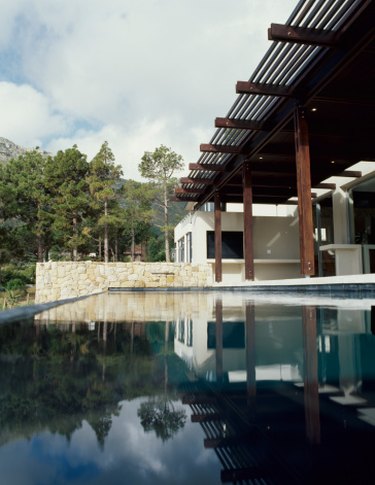
The appearance of brown algae on the bottom of the pool is a sign of the beginning of an infestation of mustard algae. This is one of the most difficult types of algae to get rid of, and gets its name from its yellowish-brown color. Treatment should begin as soon as these spots appear and may need to be repeated several times before the algae is gone.
Identification
Video of the Day
Most other types of algae can be found floating on the surface of the water or stuck to the walls of the pool near the water line. Mustard algae is different, as it appears as brown patches on the bottom. It can easily be mistaken for dirt, as the color and appearance of texture is the same. It can be vacuumed up in the same way dirt can, but will generally return within a day. In most cases, the algae will re-form in the same spot. This is usually because there are some areas of the pool that get less circulation and have a smaller percentage of chemicals present, and this is where the algae will settle.
Video of the Day
To be sure it is mustard algae and not fine dirt or silt, touch the spots. Dirt will have a distinctly gritty feel, while mustard algae will have a slimy feel similar to other algae.
Difficulty in Removing
Brown or mustard algae is one of the most difficult types of algae to completely remove. It is highly resistance to chlorine and other sanitizers, which can cope with other forms of algae fairly efficiently. The individual grains of mustard algae are very small; this means that even if they are vacuumed up, they can pass through most filtration systems and be pumped right back into the water.
Control
The first step in eliminating the growth of brown spots of algae is to test and manage the pool's pH. The pH is a measure of how acidic or alkaline the water is, and the ideal range is between 7.2 and 7.8. Outside this range, the pool can become a breeding ground for algae. Once the range is balanced, it will also allow the chemicals to work properly. Since brown algae is extremely chlorine-resistant, several other chemicals such as shock and an algaecide specifically designed for mustard algae will help get rid of the infestation. This will often result in cloudy pool water, so use clarifier to correct this problem.
In addition to the chemicals, one of the most important steps is to continuously brush the algae to dislodge it from the bottom of the pool. Do this throughout the treatment, and it will allow the chemicals access to the algae growth. Rinse the pool filter out at least twice a day during treatment to get rid of the organisms that the filtration system catches.
Prevention
Keeping the pool pH between 7.2 and 7.8 will go a long way in preventing the algae growths from forming. This environment is less than favorable to the growth of algae and will also raise the efficiency of the chemicals in the pool. Regular vacuuming and cleaning of the pool will also help, as will changing or rinsing the filter. Be sure to keep the pool properly chlorinated; determining the proper amount to add on a daily basis varies based on environmental and water conditions, as well as on the size of the pool.
- Clean Pool and Spa: Brown Algae and Swimming Pool Chemistry
- Par Pool and Spa: Types of Algae in Swimming Pools & Treatment
- Michigan State University PESTED: Pests of Pools
- Memphis Pool: The Challenge of Mustard Algae
- Michigan State University PESTED: Swimming Pool Pest Management; William de Haan